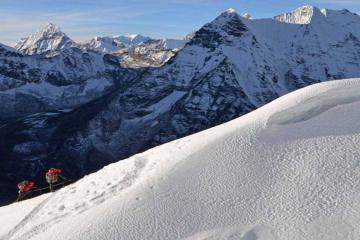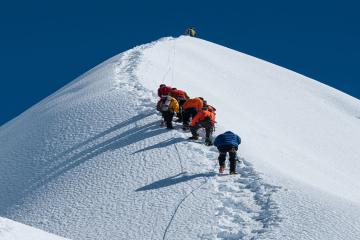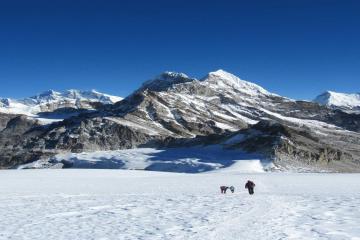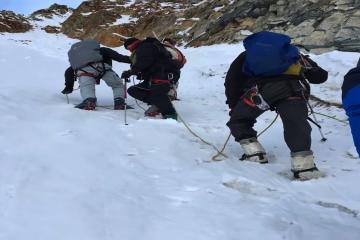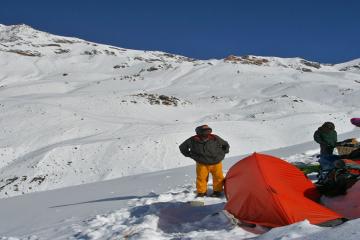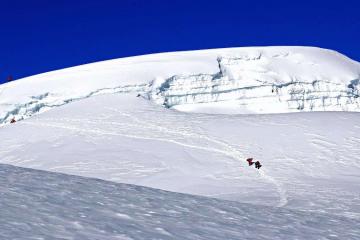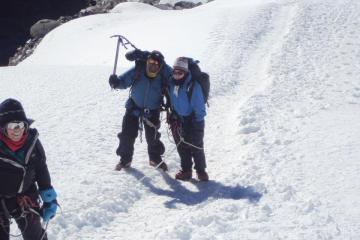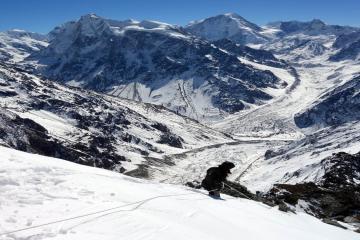Peak climbing in Nepal
Discover the exhilarating world of Peak climbing in Nepal. From Mera Peak, Island Peak, and Chulu-East Peak to lesser-known gems like Paldor and Pharchamo Peak. Uncover the beauty of the trekking peaks, and learn about essential preparations and acclimatization for Peak Climbing in Nepal.
"Seize New Heights: Encounter the Thrill of Peak Climbing in Nepal!"
What are Trekking peaks in Nepal?
Trekking peaks in Nepal emerged in the 1950s when Nepal opened its doors to foreign mountaineers and trekkers. The successful ascent of Mount Everest by Sir Edmund Hillary and Tenzing Norgay Sherpa in 1953 sparked great interest in Nepal as a top destination for mountaineering. Initially, the focus was mainly on conquering the highest peaks like Everest, Kanchenjunga, and Makalu. However, as more explorers ventured into the region, they discovered smaller peaks offering breathtaking views and relatively uncomplicated routes. These peaks provided an opportunity for adventure enthusiasts to test their abilities and reach summits without requiring extensive technical skills.
The Nepal Mountaineering Association (NMA), established in 1973, played a crucial role in promoting and regulating climbing activities in Nepal. As trekking grew in popularity, the NMA identified a group of mountains that could be classified as "trekking peaks" due to their accessibility and relatively less demanding nature compared to major expedition peaks. The NMA designated these peaks as "Group A" and "Group B" peaks, based on their height and technical difficulty.
Group A peaks include popular names like Island Peak (6,189 meters), Mera Peak (6,476 meters), and Lobuche East (6,119 meters). These peaks required climbers to possess some basic mountaineering skills, including the use of ice axes, crampons, and roped travel on glaciers. Climbing permits were introduced for these peaks, and climbers were required to be accompanied by a licensed climbing guide.
Group B peaks, on the other hand, were relatively lower in altitude and required less technical expertise. Peaks like Yala Peak (5,520 meters) and Pisang Peak (6,091 meters) fall under this category. While climbers still needed to obtain permits, the requirement for a licensed guide was not mandatory.
Let's dive into the different trekking peaks located in the various regions of Nepal:
Acclimatization for Peak Climbing in Nepal
Acclimatization is a crucial aspect of peak climbing in Nepal as it allows the body to adjust gradually to high altitudes, reducing the risk of altitude-related illnesses and ensuring a safer and more enjoyable climbing experience. When planning your climb, it is essential to allow for a gradual ascent, avoiding rapid altitude gains that can increase the likelihood of altitude sickness. Most organized climbing expeditions incorporate rest days and gradual elevation gains to aid in acclimatization. These rest days provide an opportunity for the body to adapt to the altitude by staying at a specific elevation, often involving short hikes to higher altitudes and then descending to sleep at a lower altitude. Proper hydration and nutrition are also vital during acclimatization, as they support energy levels and aid in the body's adaptation to altitude. Drinking plenty of fluids such as water or herbal teas, and maintaining a balanced diet contribute to a successful acclimatization process. In some cases, climbers may consider using altitude medication to prevent or alleviate symptoms of altitude sickness, but it should not replace the importance of proper acclimatization practices. It is essential to listen to your body and communicate any symptoms of altitude sickness to your climbing team and guides. If experiencing headaches, dizziness, nausea, or shortness of breath, it is crucial to take appropriate measures, such as descending to a lower altitude. Prior physical fitness and conditioning play a significant role in acclimatization, so engaging in regular cardiovascular exercise and strength training before the climb is recommended to improve overall fitness and endurance.
Equipment for Peak Climbing in Nepal
Specialized equipment is necessary for safe and successful peak climbing in Nepal's challenging mountain environments. Key gear includes mountaineering boots, crampons, ice axes, harnesses, climbing helmets, ropes, carabiners, and quickdraws. It is crucial to have appropriate mountaineering clothing, including layered insulation and protective outer shells. Carrying a backpack for personal gear and a warm sleeping bag with a sleeping pad for comfort during high-altitude camps is essential. Navigation tools like maps and compasses, communication devices such as satellite phones, and a reliable headlamp are vital for navigation and safety. A well-stocked first aid kit is also important. Seeking advice from experienced climbers or trekking agencies is advisable to ensure specific equipment needs are met.
Climbing Permits in Nepal
Climbing permit fees in Nepal for Trekking Peaks vary depending on the peak's altitude and location. These fees are charged by the Nepal Mountaineering Association (NMA) and are used for the conservation and maintenance of the trekking routes and peak areas. They are valid for a specific duration, usually between one and four weeks. For instance, Mount Everest, which stands at 8848 meters, has two different routes, and the permit fees for the normal route are $11000 in the spring, $5500 in the autumn, and $2750 in the winter/summer. For the other route, the permit fees are $10000 in the spring, $5000 in the autumn, and $2500 in the winter/summer. Below is a table highlighting the permit fees for trekking peaks(per person):
Name of the Peak |
Permit Fees for Nepali Climbers(NPR) |
Permit Fees for Foreign Climbers(USD) |
||||
|
Spring |
Autumn |
Winter and Summer |
Spring |
Autumn |
Winter and Summer |
|
Mera Peak Climbing |
4000 |
2000 |
1000 |
250 |
125 |
70 |
Island Peak Climbing |
4000 |
2000 |
1000 |
250 |
125 |
70 |
Lobuche East Peak |
4000 |
2000 |
1000 |
250 |
125 |
70 |
Chulu East |
5000 |
2500 |
1250 |
400 |
200 |
100 |
Pisang Peak |
4000 |
2000 |
1000 |
250 |
125 |
70 |
Chulu West Peak |
4000 |
2000 |
1000 |
250 |
125 |
70 |
Kwangde Peak |
4000 |
2000 |
1000 |
250 |
125 |
70 |
Pachermo Peak |
4000 |
2000 |
1000 |
250 |
125 |
70 |
Additionally, climbers are required to obtain a TIMS (Trekkers’ Information Management System) card and a Sagarmatha National Park permit, both of which are necessary for any trek or climb in the Everest region. The fees for these permits are separate from the climbing permit fee and vary depending on the season and duration of the trek or climb. It is essential to obtain the necessary permits and pay the fees before the climb as unauthorized climbing is prohibited in Nepal.
Documents Required for Peak Climbing
Peak climbing in Nepal is a thrilling adventure that requires a few essential documents for a successful trip. The primary document you need is a climbing permit issued by the Nepal Mountaineering Association. You also need a trekking permit, insurance, and a TIMS card. These documents ensure your safety and compliance with local regulations. Additionally, you may need a medical certificate and visa to enter Nepal. It's crucial to research and prepare all necessary documents before your climb to avoid any delays or legal issues. With the right documents in hand, you can focus on experiencing the breathtaking views and challenges of peak climbing in Nepal.
Climbing Training in Nepal
It's important to have the right training and skills for trekking peaks. They can be acquired through climbing training programs offered in Nepal. These programs cover various aspects of climbing, such as rock climbing, ice climbing, glacier travel, rope handling, and rescue techniques. They also provide a comprehensive understanding of the local weather conditions, geography, and culture. Climbing training in Nepal is conducted by experienced and certified guides who have extensive knowledge of the peaks and are trained in first aid and rescue operations. Climbing training programs can range from a few days to several weeks, depending on the level of expertise required. By participating in these programs, climbers can not only develop their skills but also gain a deeper appreciation of the mountains and the natural beauty of Nepal. Here are a few examples of climbing training programs in Nepal:
-
Nepal Mountaineering Association (NMA) Climbing Course:
This is a popular climbing training program offered by the Nepal Mountaineering Association (NMA) and is designed for beginner and intermediate climbers. -
International Mountain Climbing School (IMCS):
The International Mountain Climbing School (IMCS) is a leading climbing school in Nepal and offers a range of climbing courses, from beginner to advanced levels.
Best Seasons for Climbing Peaks in Nepal
The best seasons for climbing trekking peaks in Nepal are generally the spring (March to May) and the autumn (September to November). These seasons offer the most favorable weather and climbing conditions, with clear skies, mild temperatures, and stable weather patterns.
In the spring, the weather is usually dry and mild, making it an ideal time for climbing. The higher temperatures also help to melt snow and ice, making the trails and climbing routes more accessible.
In the autumn, the weather is typically clear and dry, with stable conditions for climbing. The cooler temperatures also help to reduce the risk of altitude sickness, making it a safer time to climb. Additionally, the autumn months are less crowded than the spring, making it a good option for those looking for a quieter climbing experience.
While climbing can be done in the winter (December to February) and the summer (June to August), these seasons are generally not recommended for trekking peaks. The winter months can be extremely cold and snowy, making the climb more challenging and dangerous. The summer months bring heavy monsoon rains and cloud cover, making it difficult to trek and climb in the mountains.
Essential types of equipment required for Peak Climbing
Peak climbing in Nepal is a challenging and exciting adventure activity that requires specialized equipment to ensure safety and success. Some of the essential equipment required for peak climbing in Nepal are:
- Climbing Boots: A good quality pair of climbing boots is essential to provide stability and support to your feet while climbing on rocks and ice.
- Crampons: Crampons are metal spikes that attach to your climbing boots and help you to grip onto the snow and ice while climbing.
- Ice Axe: An ice axe is used for balance and self-arrest, and it is an essential tool for climbing on snow and ice.
- Harness: A climbing harness is used to secure yourself to a rope and to prevent falls during the climb.
- Rope: A climbing rope is used to secure yourself to your climbing partner or anchor points and for rappelling.
- Carabiners: Carabiners are metal clips that are used to attach various pieces of climbing equipment together.
- Helmet: A climbing helmet is essential to protect your head from falling rocks or other objects.
- Mountaineering Clothing: You need specialized clothing to keep you warm and protected from harsh weather conditions, including insulated jackets, pants, gloves, and hats.
- Backpack: You need a good quality backpack to carry all of your climbing equipment, food, and water.
- Oxygen cylinders and masks: For high-altitude climbing, it may be necessary to carry oxygen cylinders and masks to prevent altitude sickness.
It is important to have all the necessary equipment before embarking on peak climbing in Nepal. It is also essential to have proper training and experience in mountain climbing and to hire a professional guide to ensure your safety during the climb.
Safety Tips for Peak Climbing in Nepal
Trekking peak climbing in Nepal can be an incredible experience, but it's essential to take safety measures and precautions to ensure a safe and enjoyable climb. Here are some important safety measures and precautions to keep in mind:
- Acclimatization: Proper acclimatization is crucial for safe climbing. Climbers should take the necessary time to acclimatize to high altitudes before attempting to climb. It's recommended to climb high and sleep low to help the body adjust to higher altitudes slowly.
- Hire experienced guides: It's essential to hire experienced guides who are familiar with the terrain and weather conditions of the region. They can provide valuable assistance and knowledge on the trek, making it safer and more enjoyable.
- Carry proper gear: Carrying the right gear is crucial for safe climbing. Climbers should bring proper mountaineering equipment such as crampons, ice axes, ropes, and helmets. It's also important to bring proper clothing and gear to protect against cold temperatures, high winds, and other weather conditions.
- Stay hydrated: Climbers should drink plenty of water to stay hydrated and avoid altitude sickness. Dehydration can make altitude sickness symptoms worse, so it's essential to drink enough water throughout the trek.
- Follow the trekking regulations: Climbers should follow the trekking regulations set by the Nepal government, such as obtaining proper permits and hiring registered guides and porters. This helps to ensure that climbers are safe and accounted for during the climb.
- Be prepared for emergencies: Climbers should carry a first aid kit and emergency supplies such as a satellite phone, GPS, and emergency shelter. It's also important to have an evacuation plan in case of an emergency.
By taking these safety measures and precautions, climbers can have a safe and enjoyable trekking peak climbing experience in Nepal.
Accessible Adventure for the Best Peak Climbing Experience
At Accessible Adventure, we offer excellent packages for those seeking a peak climbing adventure in Nepal. With our team of expert guides and extensive experience in the field, we have established ourselves as a trusted and reputable trekking company. Our highly skilled guides are well-versed in the technical aspects of peak climbing and possess a deep understanding of the Nepalese mountains. Over the years, we have successfully organized numerous peak climbing expeditions, showcasing our ability to handle logistics, provide the necessary equipment, and overcome the challenges that arise during climbs. Safety is our utmost priority, and we meticulously plan well-structured itineraries that include proper acclimatization.
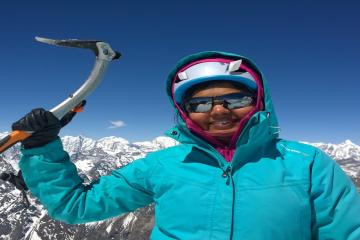
Lobuche Peak Climbing With Everest Base Camp Trek
Per Person
